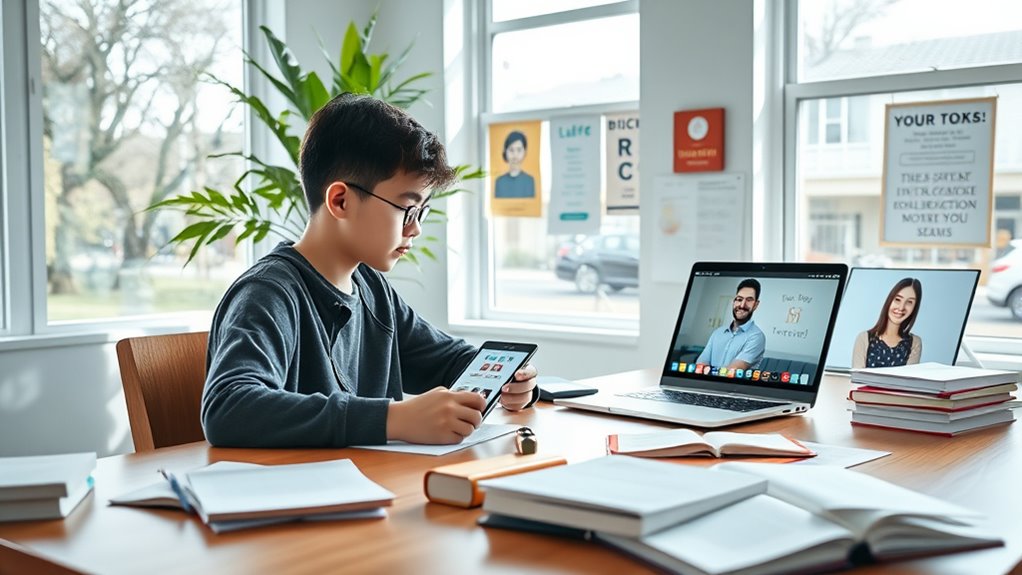By combining tutoring with self-study, you can create a personalized and efficient learning plan. Use tutoring sessions to identify your strengths and weaknesses, then apply those insights during independent practice. Set clear goals, break tasks into manageable steps, and track your progress regularly. Stay motivated with rewards and routines. This balanced approach boosts understanding and retention, enabling you to reach your goals faster. Continue exploring how to maximize your learning potential with these strategies.
Key Takeaways
- Use tutoring insights to identify specific learning needs and tailor your self-study approach accordingly.
- Revisit concepts learned in tutoring during self-study to reinforce understanding and retention.
- Employ personalized study methods, such as visual aids and flashcards, based on guidance from your tutor.
- Set clear goals and track progress to stay motivated and adjust strategies for continuous improvement.
- Balance guided instruction with autonomous practice to maximize learning efficiency and academic success.

Have you ever wondered how to make your study sessions more effective? When you’re juggling self-study and tutoring, blending these approaches can considerably boost your learning. One key way to do this is by focusing on personalized learning. Everyone has unique strengths, weaknesses, and learning styles, so tailoring your study methods ensures you’re not wasting time on strategies that don’t work for you. During tutoring sessions, your tutor can help identify your specific needs, which you can then incorporate into your self-study routine. For example, if you find visual aids helpful, you can create mind maps or infographics to reinforce your understanding. If you struggle with memorization, flashcards or spaced repetition techniques might be more effective. Personalizing your learning process makes each study session more engaging and efficient because you’re focusing on what truly benefits you.
Motivation strategies also play an essential role when integrating tutoring with self-study. You might start with the motivation to achieve a certain grade or master a difficult concept, but keeping that drive alive is crucial. During tutoring, your instructor can help set clear, achievable goals, which you can then pursue independently. Break larger tasks into smaller, manageable steps, and celebrate your progress along the way. Establishing a routine also helps maintain motivation; for instance, dedicating specific times for tutoring and self-study fosters consistency. Incorporate rewards for meeting milestones—like taking a break, enjoying a snack, or doing something you love—to reinforce positive habits. By staying motivated, you’re more likely to stay committed to your study plan and see tangible results.
Combining tutoring with self-study allows you to personalize your learning environment and apply motivation strategies effectively. Use insights gained during tutoring sessions to guide your independent work, and don’t hesitate to revisit concepts that still seem unclear. Keep a journal or a progress tracker to monitor your improvements and setbacks, which keeps you aware of your growth and encourages persistence. Remember, the most successful learners adapt their strategies based on what works best for them, and seeking a balance between guided instruction and autonomous effort maximizes your learning potential. When you actively customize your approach and stay motivated, you turn your study sessions into a more productive, engaging experience, ultimately helping you reach your academic goals faster.
Frequently Asked Questions
How Can I Balance Tutoring Sessions With Self-Study Time Effectively?
To balance tutoring sessions with self-study, create a study schedule that allocates specific times for both activities, ensuring consistency. Use motivation techniques like setting small goals and rewarding yourself to stay engaged. Prioritize challenging topics during your tutoring sessions and review them during self-study. Stay flexible, monitor your progress, and adjust your schedule as needed, so you maintain steady momentum without feeling overwhelmed.
What Are the Signs I Need More Tutoring Versus Self-Study?
Did you know students who seek extra tutoring improve their understanding by up to 50%? If your study habits stall or motivation challenges persist despite consistent effort, it’s time for more tutoring. Signs include persistent confusion, difficulty applying concepts, or feeling overwhelmed by self-study. When you notice these, increasing tutoring sessions can provide targeted support, helping you stay engaged and effectively address areas where self-study alone isn’t enough.
How Do I Choose the Right Tutor for My Learning Style?
To select the right tutor for your learning style, first identify whether you’re a visual, auditory, or kinesthetic learner. Look for a tutor who demonstrates compatibility with your preferred learning methods, such as using visuals or hands-on activities. Ask about their teaching approach and experience to make certain they can adapt to your needs. Ultimately, a compatible tutor will make learning engaging and effective, helping you reach your goals faster.
Can Online Tutoring Be as Effective as In-Person Sessions?
Oh sure, online tutoring can totally replace in-person sessions—just like a virtual handshake. You get real-time virtual engagement and personalized feedback right from your device. While some miss the face-to-face vibe, many find the convenience and tailored approach just as effective. With the right tech setup and active participation, you’ll discover that online tutoring can be just as impactful, helping you learn efficiently from anywhere.
What Tools or Resources Enhance Integrated Tutoring and Self-Study?
You can enhance your integrated tutoring and self-study by using interactive apps and digital flashcards. Interactive apps keep you engaged with quizzes, videos, and real-time feedback, making learning dynamic. Digital flashcards help reinforce key concepts and improve memory retention through active recall. Combining these tools with your tutoring sessions creates a well-rounded approach, allowing you to practice independently while benefiting from personalized guidance, ultimately boosting your understanding and progress.
Conclusion
By blending tutoring with self-study, you create a learning experience that’s as balanced as a tightrope walker. This approach helps you stay motivated, clear doubts, and reinforce concepts effectively. Think of tutoring as your guiding hand and self-study as your steady footing—together, they keep you moving forward confidently. When you combine these methods, you maximize your learning potential and turn challenges into opportunities, making your educational journey smoother and more rewarding.










